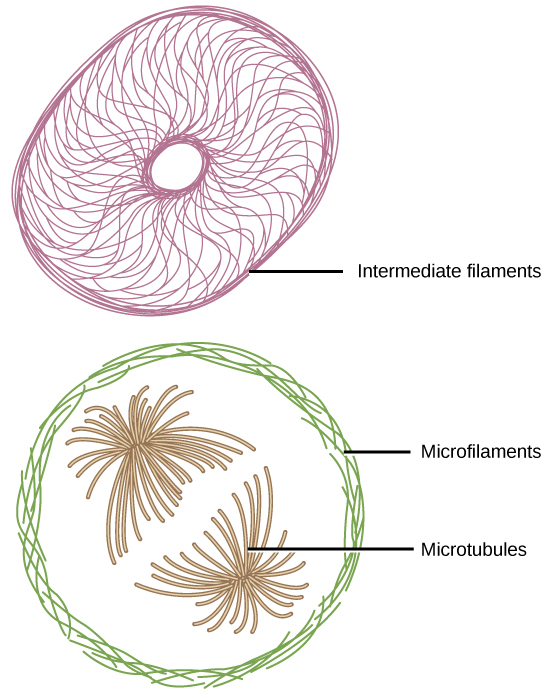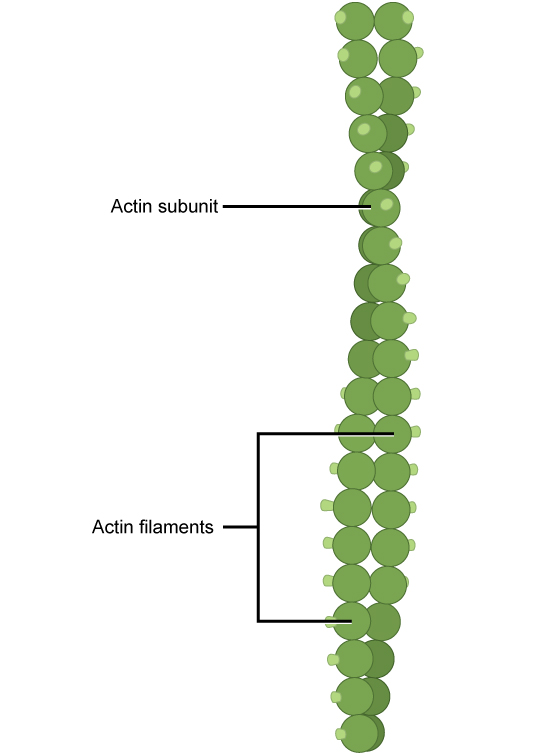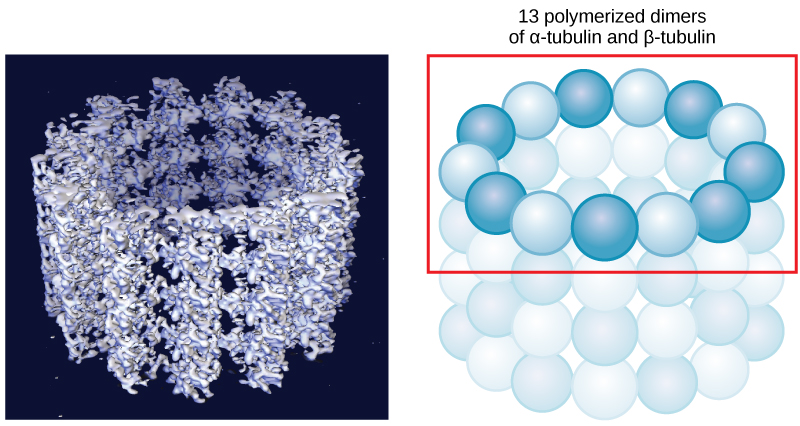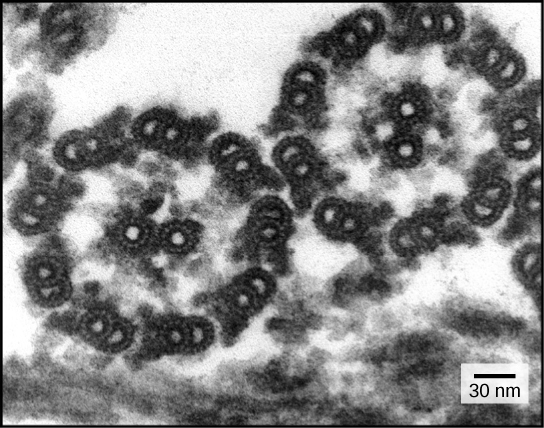What Does The Cytoskeleton Do In An Animal Cell
Cell Structure
xix The Cytoskeleton
Learning Objectives
By the end of this section, y'all will be able to exercise the post-obit:
- Describe the cytoskeleton
- Compare the roles of microfilaments, intermediate filaments, and microtubules
- Compare and contrast cilia and flagella
- Summarize the differences amongst the components of prokaryotic cells, animal cells, and plant cells
If you were to remove all the organelles from a cell, would the plasma membrane and the cytoplasm be the only components left? No. Within the cytoplasm, at that place would still exist ions and organic molecules, plus a network of poly peptide fibers that help maintain the cell'due south shape, secure some organelles in specific positions, allow cytoplasm and vesicles to move inside the cell, and enable cells within multicellular organisms to movement. Collectively, scientists call this network of protein fibers the cytoskeleton. There are iii types of fibers inside the cytoskeleton: microfilaments, intermediate filaments, and microtubules ((Figure)). Here, nosotros will examine each.
Microfilaments thicken the cortex effectually the cell'southward inner edge. Like rubber bands, they resist tension. There are microtubules in the prison cell'due south interior where they maintain their shape by resisting compressive forces. In that location are intermediate filaments throughout the prison cell that hold organelles in place.

Microfilaments
Of the 3 types of protein fibers in the cytoskeleton, microfilaments are the narrowest. They function in cellular movement, have a bore of about 7 nm, and are comprised of 2 globular protein intertwined strands, which we call actin ((Effigy)). For this reason, we besides phone call microfilaments actin filaments.
Two intertwined actin strands comprise microfilaments.

ATP powers actin to assemble its filamentous form, which serves as a track for the motion of a motor poly peptide we call myosin. This enables actin to appoint in cellular events requiring motion, such as cell sectionalisation in eukaryotic cells and cytoplasmic streaming, which is the cell cytoplasm'southward circular motility in plant cells. Actin and myosin are plentiful in muscle cells. When your actin and myosin filaments slide past each other, your muscles contract.
Microfilaments also provide some rigidity and shape to the cell. They tin can depolymerize (disassemble) and reform quickly, thus enabling a jail cell to change its shape and move. White blood cells (your body'south infection-fighting cells) make good use of this ability. They can motility to an infection site and phagocytize the pathogen.
Link to Learning
To run across an instance of a white claret jail cell in action, watch a curt fourth dimension-lapse video of the cell capturing two bacteria. Information technology engulfs one and then moves on to the other.
Intermediate Filaments
Several strands of gristly proteins that are wound together comprise intermediate filaments ((Figure)). Cytoskeleton elements go their proper name from the fact that their diameter, 8 to 10 nm, is between those of microfilaments and microtubules.
Intermediate filaments consist of several intertwined strands of fibrous proteins.

Intermediate filaments have no role in prison cell move. Their part is purely structural. They carry tension, thus maintaining the prison cell's shape, and anchor the nucleus and other organelles in place. (Figure) shows how intermediate filaments create a supportive scaffolding inside the cell.
The intermediate filaments are the most diverse group of cytoskeletal elements. Several fibrous protein types are in the intermediate filaments. You are probably most familiar with keratin, the fibrous protein that strengthens your pilus, nails, and the skin's epidermis.
Microtubules
Every bit their proper name implies, microtubules are small hollow tubes. Polymerized dimers of α-tubulin and β-tubulin, two globular proteins, comprise the microtubule's walls ((Figure)). With a bore of about 25 nm, microtubules are cytoskeletons' widest components. They help the jail cell resist compression, provide a rail along which vesicles motility through the cell, and pull replicated chromosomes to opposite ends of a dividing jail cell. Like microfilaments, microtubules can detach and reform quickly.
Microtubules are hollow. Their walls consist of 13 polymerized dimers of α-tubulin and β-tubulin (right image). The left image shows the tube's molecular construction.

Microtubules are likewise the structural elements of flagella, cilia, and centrioles (the latter are the centrosome's two perpendicular bodies). In animate being cells, the centrosome is the microtubule-organizing heart. In eukaryotic cells, flagella and cilia are quite different structurally from their counterparts in prokaryotes, as nosotros discuss below.
Flagella and Cilia
The flagella (singular = flagellum) are long, pilus-like structures that extend from the plasma membrane and enable an unabridged cell to move (for example, sperm, Euglena, and some prokaryotes). When present, the cell has simply ane flagellum or a few flagella. However, when cilia (singular = cilium) are nowadays, many of them extend along the plasma membrane'southward entire surface. They are short, hair-like structures that motility entire cells (such equally paramecia) or substances along the prison cell's outer surface (for example, the cilia of cells lining the Fallopian tubes that motion the ovum toward the uterus, or cilia lining the cells of the respiratory tract that trap particulate matter and move it toward your nostrils.)
Despite their differences in length and number, flagella and cilia share a common structural organisation of microtubules called a "9 + 2 assortment." This is an advisable name because a single flagellum or cilium is made of a band of nine microtubule doublets, surrounding a unmarried microtubule doublet in the centre ((Figure)).
This manual electron micrograph of two flagella shows the microtubules' 9 + 2 array: 9 microtubule doublets surround a single microtubule doublet. (credit: modification of work by Dartmouth Electron Microscope Facility, Dartmouth College; scale-bar data from Matt Russell)

You have now completed a broad survey of prokaryotic and eukaryotic prison cell components. For a summary of cellular components in prokaryotic and eukaryotic cells, see (Effigy).
| Components of Prokaryotic and Eukaryotic Cells | ||||
|---|---|---|---|---|
| Prison cell Component | Function | Present in Prokaryotes? | Nowadays in Animal Cells? | Nowadays in Plant Cells? |
| Plasma membrane | Separates cell from external surroundings; controls passage of organic molecules, ions, water, oxygen, and wastes into and out of cell | Yes | Yes | Yeah |
| Cytoplasm | Provides turgor pressure to plant cells every bit fluid inside the cardinal vacuole; site of many metabolic reactions; medium in which organelles are institute | Yep | Yes | Yes |
| Nucleolus | Darkened area within the nucleus where ribosomal subunits are synthesized. | No | Yeah | Yes |
| Nucleus | Cell organelle that houses Dna and directs synthesis of ribosomes and proteins | No | Yes | Yes |
| Ribosomes | Protein synthesis | Yes | Yes | Yes |
| Mitochondria | ATP product/cellular respiration | No | Yes | Yes |
| Peroxisomes | Oxidize and thus intermission downward fatty acids and amino acids, and detoxify poisons | No | Yes | Yes |
| Vesicles and vacuoles | Storage and transport; digestive function in plant cells | No | Yes | Yep |
| Centrosome | Unspecified office in prison cell segmentation in animate being cells; microtubule source in beast cells | No | Yep | No |
| Lysosomes | Digestion of macromolecules; recycling of worn-out organelles | No | Yes | Some |
| Cell wall | Protection, structural back up, and maintenance of cell shape | Aye, primarily peptidoglycan | No | Yes, primarily cellulose |
| Chloroplasts | Photosynthesis | No | No | Yes |
| Endoplasmic reticulum | Modifies proteins and synthesizes lipids | No | Yep | Aye |
| Golgi appliance | Modifies, sorts, tags, packages, and distributes lipids and proteins | No | Yes | Yes |
| Cytoskeleton | Maintains cell'southward shape, secures organelles in specific positions, allows cytoplasm and vesicles to move inside prison cell, and enables unicellular organisms to motion independently | Yeah | Yes | Yep |
| Flagella | Cellular locomotion | Some | Some | No, except for some plant sperm cells |
| Cilia | Cellular locomotion, movement of particles along plasma membrane's extracellular surface, and filtration | Some | Some | No |
Section Summary
The cytoskeleton has iii different poly peptide element types. From narrowest to widest, they are the microfilaments (actin filaments), intermediate filaments, and microtubules. Biologists oft associate microfilaments with myosin. They provide rigidity and shape to the cell and facilitate cellular movements. Intermediate filaments bear tension and anchor the nucleus and other organelles in place. Microtubules help the cell resist compression, serve every bit tracks for motor proteins that move vesicles through the prison cell, and pull replicated chromosomes to opposite ends of a dividing cell. They are likewise the structural chemical element of centrioles, flagella, and cilia.
Review Questions
Which of the following have the ability to disassemble and reform quickly?
- microfilaments and intermediate filaments
- microfilaments and microtubules
- intermediate filaments and microtubules
- only intermediate filaments
B
Which of the following do not play a office in intracellular move?
- microfilaments and intermediate filaments
- microfilaments and microtubules
- intermediate filaments and microtubules
- only intermediate filaments
D
In humans, _____ are used to move a cell within its environment while _____ are used to move the environment relative to the prison cell.
- cilia, pseudopodia
- flagella; cilia
- microtubules; flagella
- microfilaments; microtubules
B
Disquisitional Thinking Questions
What are the similarities and differences betwixt the structures of centrioles and flagella?
Centrioles and flagella are alike in that they are made up of microtubules. In centrioles, ii rings of ix microtubule "triplets" are bundled at right angles to one some other. This arrangement does not occur in flagella.
How do cilia and flagella differ?
Cilia and flagella are alike in that they are made up of microtubules. Cilia are brusque, pilus-like structures that exist in large numbers and usually cover the unabridged surface of the plasma membrane. Flagella, in dissimilarity, are long, hair-like structures; when flagella are present, a cell has merely ane or ii.
Depict how microfilaments and microtubules are involved in the phagocytosis and devastation of a pathogen by a macrophage.
A macrophage engulfs a pathogen by rearranging its actin microfilaments to curve the plasma membrane effectually the pathogen. Once the pathogen is sealed in an endosome inside the macrophage, the vesicle is walked along microtubules until it combines with a lysosome to digest the pathogen.
Compare and contrast the boundaries that plant, animal, and bacteria cells utilize to split up themselves from their surrounding surroundings.
All three cell types have a plasma membrane that borders the cytoplasm on its interior side. In animal cells, the exterior side of the plasma membrane is in contact with the extracellular environment. Withal, in institute and bacteria cells, a jail cell wall surrounds the outside of the plasma membrane. In plants, the prison cell wall is made of cellulose, while in leaner the cell wall is made of peptidoglycan. Gram-negative leaner too accept an additional sheathing fabricated of lipopolysaccharides that surrounds their cell wall.
Glossary
- cilium
- (plural = cilia) short, hair-like structure that extends from the plasma membrane in large numbers and functions to move an entire prison cell or move substances along the cell'southward outer surface
- cytoskeleton
- protein cobweb network that collectively maintains the cell'southward shape, secures some organelles in specific positions, allows cytoplasm and vesicles to motion within the prison cell, and enables unicellular organisms to move independently
- flagellum
- (plural = flagella) long, pilus-like structure that extends from the plasma membrane and moves the prison cell
- intermediate filament
- cytoskeletal component, comprised of several fibrous protein intertwined strands, that bears tension, supports jail cell-cell junctions, and anchors cells to extracellular structures
- microfilament
- the cytoskeleton system'southward narrowest element; it provides rigidity and shape to the prison cell and enables cellular movements
- microtubule
- the cytoskeleton system's widest element; it helps the cell resist compression, provides a track along which vesicles move through the cell, pulls replicated chromosomes to opposite ends of a dividing jail cell, and is the structural element of centrioles, flagella, and cilia
Source: https://opentextbc.ca/biology2eopenstax/chapter/the-cytoskeleton/
Posted by: ornelasproffecanded.blogspot.com

0 Response to "What Does The Cytoskeleton Do In An Animal Cell"
Post a Comment